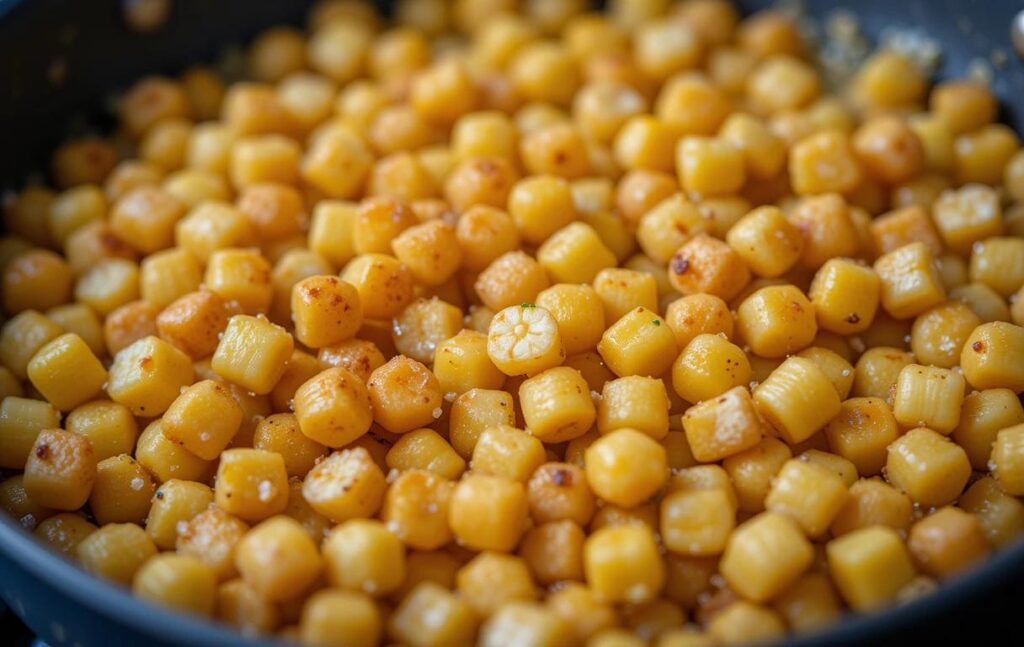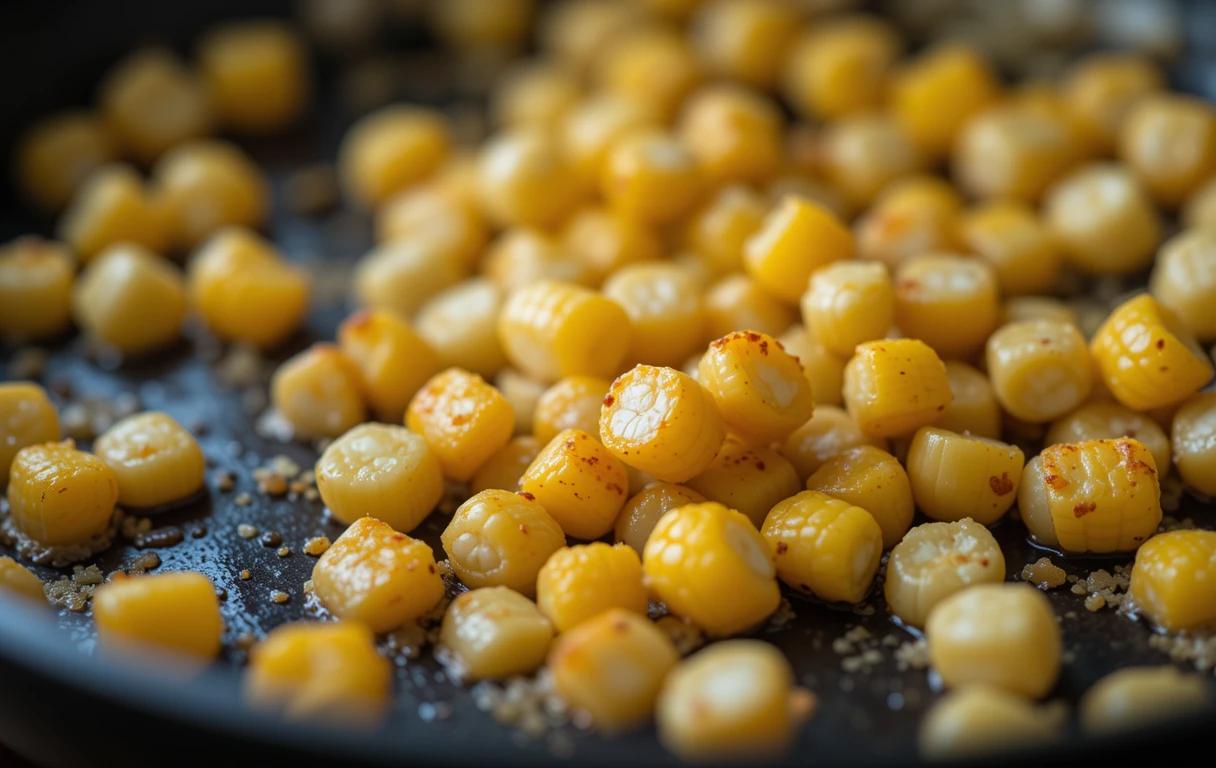Is it good to eat fried corn? Fried corn has become a popular snack and side dish enjoyed around the world. With its crunchy texture and mouthwatering flavor, it’s easy to see why people love this treat. But when it comes to health, is eating fried corn a smart choice, or does it pose risks? In this article, we’ll explore the nutritional benefits and downsides of fried corn, including its calorie content, fats, and alternatives that can help you make a healthier choice.
Corn itself is a highly nutritious food packed with fiber, vitamins, and antioxidants. However, the way you cook it can change its health profile significantly. Let’s break down everything you need to know about eating fried corn—starting with its origins and how it’s made.
What is Fried Corn?
Fried corn is a delicious dish made by cooking fresh or canned corn kernels in oil, butter, or fat. The cooking process gives it a golden, crispy texture and enhances its natural sweetness. Fried corn can be enjoyed as a snack, a side dish, or even a topping for salads and soups. Popular variations include seasoning it with salt, pepper, spices like paprika, garlic powder, or adding a sprinkle of cheese for extra flavor.
This versatile dish is loved globally, from street vendors to home kitchens, for its simplicity and bold flavor. However, the healthiness of fried corn depends largely on the method of preparation and the amount of oil or butter used.
Nutritional Value of Corn
Corn, in its natural state, is highly nutritious and offers a range of health benefits. Here’s a breakdown of its key nutrients per 100 grams of cooked corn:
| Nutrient | Amount | Benefits |
|---|---|---|
| Calories | 96 kcal | Provides energy for daily activities |
| Carbohydrates | 21g | Main source of fuel for the body |
| Fiber | 2.4g | Supports digestion and improves gut health |
| Protein | 3.4g | Essential for tissue repair and muscle growth |
| Fat | 1.5g | Low-fat option when cooked without oil |
| Vitamin B6 | 0.1mg | Boosts brain health and energy metabolism |
| Folate (B9) | 42mcg | Supports cell function and tissue growth |
| Magnesium | 37mg | Promotes bone health and reduces fatigue |
Corn is naturally gluten-free, making it suitable for people with gluten intolerance or celiac disease. It’s also a great source of antioxidants, which help protect the body from oxidative stress and inflammation.
Health Benefits of Eating Corn
1. High in Fiber
Corn is an excellent source of dietary fiber, which plays a key role in supporting digestive health. Fiber helps prevent constipation, improves bowel regularity, and promotes the growth of healthy gut bacteria. A high-fiber diet is also linked to a reduced risk of heart disease, diabetes, and obesity.
2. Rich in Vitamins and Minerals
Corn contains essential vitamins and minerals, such as:
- Vitamin B6: Supports energy production and brain function.
- Folate: Essential during pregnancy for fetal development.
- Magnesium: Helps maintain strong bones and regulates blood pressure.
These nutrients contribute to overall well-being and help your body perform essential functions.
3. Supports Digestive Health
The insoluble fiber in corn aids digestion by adding bulk to stool and speeding up its movement through the digestive tract. This helps prevent digestive issues like constipation and bloating. Additionally, corn’s high antioxidant content helps reduce inflammation in the gut.
Fried Corn: Calories and Fat Content
While corn itself is low in fat and calories, frying it adds significant amounts of both. The number of calories in fried corn depends on how much oil or butter is used during the cooking process.
For example:
- 1 cup of plain boiled corn contains about 96 calories.
- 1 cup of fried corn cooked in oil can have 150–200 calories or more, depending on the amount of fat absorbed.
In addition to the extra calories, frying adds unhealthy fats that may increase cholesterol levels and lead to weight gain if consumed frequently. While an occasional indulgence in fried corn is fine, it’s important to monitor portion sizes and balance it with healthier meals throughout the day.
Is Fried Corn Good for Weight Loss?
Fried corn might be tasty, but is it a good option for those looking to lose weight? The short answer is no, not when eaten frequently or in large quantities. Let’s break down why.
Caloric Density of Fried Corn
Corn on its own is low in calories and a great source of fiber, which keeps you full longer. However, frying significantly increases the calorie content. When corn kernels are cooked in butter or oil, they absorb fats, increasing the caloric density. For example:
- 1 cup of boiled corn: 96 calories, 1.5g fat
- 1 cup of fried corn: 150–200+ calories, 8–10g fat
These extra calories can make it harder to maintain a calorie deficit, which is essential for weight loss. If you regularly consume fried corn without balancing it with other healthy foods, it could contribute to weight gain instead of weight loss.
Unhealthy Fats in Fried Corn
The frying process often involves oils or butter high in saturated fats or trans fats, particularly when cooked with processed or reused oils.
- Saturated fats: Increase “bad” LDL cholesterol and may lead to heart issues if consumed in excess.
- Trans fats: These are worse and linked to obesity, inflammation, and heart disease.
If you’re trying to lose weight or improve overall health, avoiding foods cooked in excessive fats is a good strategy.
Lack of Satiety Compared to Whole Corn
Fried corn is often crunchy and delicious, making it easy to overeat. However, fried foods tend to be less satiating compared to whole, minimally processed foods.
- Boiled or steamed corn retains its fiber and nutrients, keeping you full for longer.
- Fried corn, despite tasting better, may leave you hungry sooner due to its altered fiber structure.
Pro Tip: If you’re craving fried corn, opt for a healthier alternative like air-fried corn or grilled corn to reduce fat intake and calorie overload.

Health Risks of Eating Fried Corn
While fried corn can be enjoyed occasionally, overconsumption may lead to several health concerns, including:
1. High in Unhealthy Fats
When fried, corn absorbs oils that are often rich in unhealthy fats. Over time, diets high in unhealthy fats can:
- Raise cholesterol levels
- Increase the risk of heart disease
- Lead to obesity and weight gain
Cooking corn in butter or deep frying it enhances its flavor but compromises its health benefits.
2. May Contribute to Weight Gain
Fried foods, including fried corn, are calorically dense but often nutrient-poor. This makes it easy to overconsume calories without feeling satisfied. Regular consumption of fried corn, especially when paired with other unhealthy foods, can contribute to weight gain over time.
3. May Increase Risk of Chronic Diseases
Consuming fried foods on a regular basis has been linked to chronic conditions like:
- Type 2 diabetes
- High blood pressure
- Obesity
- Heart disease
These risks arise primarily due to the saturated and trans fats used in frying, as well as the increased caloric intake from fried foods.
Healthier Alternatives to Fried Corn
To enjoy corn without compromising your health, try these healthier alternatives:
1. Grilled Corn
Grilled corn is a tasty alternative that doesn’t require unhealthy oils. Simply roast fresh corn on the cob over a grill with a light brush of olive oil and season with spices like paprika, garlic powder, or lime juice.
- Benefits: Lower fat content, rich in fiber, and packed with flavor.
2. Air-Fried Corn
If you enjoy the crunch of fried corn, consider air-frying it. Air fryers use hot air to cook food, requiring only minimal oil. You’ll get the same crispy texture without the unhealthy fats.
- How to make: Toss corn kernels in a small amount of olive oil, season with your favorite spices, and air fry for 10–15 minutes.
3. Roasted Corn
Roasting corn in the oven is another excellent alternative. Place fresh or frozen corn on a baking sheet, sprinkle some seasoning, and roast at high heat. Roasted corn retains its natural sweetness while offering a rich flavor.
Quick Comparison Table
| Cooking Method | Calories (1 cup) | Fat Content | Best For |
|---|---|---|---|
| Boiled Corn | 96 kcal | 1.5g | Weight loss, general health |
| Grilled Corn | 120 kcal | 3g | Flavorful, low-fat option |
| Air-Fried Corn | 130 kcal | 4g | Crispy texture, healthier frying |
| Fried Corn | 150–200+ kcal | 8–10g | Occasional indulgence |
How to Make Healthy Fried Corn

If you love fried corn but want to make it healthier, you can adjust the cooking method and ingredients to reduce unnecessary fats and calories while retaining its delicious flavor. Follow these simple steps to prepare a healthier version of fried corn:
Ingredients
- 2 cups of fresh corn kernels (you can also use frozen or canned corn, drained and rinsed)
- 1 tablespoon of olive oil (healthier alternative to butter or vegetable oils)
- 1 teaspoon of garlic powder
- 1/2 teaspoon of smoked paprika
- A pinch of salt and black pepper
- Optional toppings: Fresh cilantro, lime juice, or a sprinkle of parmesan cheese for added flavor.
Step-by-Step Instructions
- Heat the Pan
Use a non-stick skillet or cast-iron pan to reduce the amount of oil needed. Heat the pan over medium heat and add 1 tablespoon of olive oil. - Add the Corn Kernels
Once the oil is warm, add the corn kernels evenly to the pan. Stir frequently to ensure they cook evenly without burning. If using frozen corn, thaw it before cooking to avoid excess moisture. - Season the Corn
Sprinkle the garlic powder, smoked paprika, salt, and black pepper over the corn. Stir well to coat the kernels with the seasoning. These spices enhance the flavor without adding unnecessary fats or calories. - Cook Until Golden Brown
Continue cooking for 5–7 minutes, stirring occasionally. The corn should start turning golden brown and develop a slight char, giving it a fried-like texture and flavor. - Add Fresh Toppings
For extra flavor, squeeze a bit of lime juice over the corn or sprinkle freshly chopped cilantro. If you’re craving a cheesy twist, add a light dusting of grated parmesan cheese. - Serve and Enjoy
Remove from heat and serve immediately. This healthier version of fried corn pairs perfectly as a snack, side dish, or salad topping.
Why This Method is Healthier
- Olive Oil: Unlike butter or vegetable oil, olive oil is rich in healthy monounsaturated fats, which are good for the heart.
- Reduced Fat: Using only 1 tablespoon of oil significantly cuts down the fat content.
- Spices Over Excess Salt: Spices like paprika and garlic powder add flavor without increasing sodium intake.
By making small changes in how you cook fried corn, you can enjoy this dish guilt-free without sacrificing taste.
Frequently Asked Questions (FAQs)
1. Is fried corn healthy to eat every day?
While corn itself is healthy, fried corn should not be consumed daily due to its higher calorie and fat content. Eating it occasionally, especially when prepared using healthier methods, is a better option.
2. How many calories are in a serving of fried corn?
A typical serving of fried corn cooked in oil contains around 150–200 calories, depending on the amount of oil used. A healthier version, using less oil, reduces the calorie count to around 120–130 calories per cup.
3. Can I use frozen or canned corn for frying?
Yes! Frozen or canned corn works perfectly for frying. Be sure to thaw frozen corn and drain canned corn thoroughly to prevent excess moisture during cooking.
4. What is the best oil for making healthy fried corn?
Olive oil, avocado oil, or coconut oil are the best choices for frying corn as they are rich in healthy fats and have a higher smoke point. Avoid using highly processed oils like vegetable oil.
5. Is corn good for weight loss?
Yes, corn can be part of a weight-loss diet when prepared healthily. Corn is low in fat and high in fiber, which keeps you full longer. However, avoid fried versions with excess oil.
6. What are some healthy seasonings for fried corn?
Healthy seasonings include garlic powder, smoked paprika, chili powder, cumin, lime juice, and fresh herbs like cilantro or parsley. These options add flavor without extra calories or sodium.
Healthier Alternatives to Fried Corn
If you love corn but want to avoid the added calories and unhealthy fats that come with frying, there are healthier ways to prepare it without compromising on flavor. Below are three nutritious alternatives to fried corn that are both delicious and easy to make:
1. Grilled Corn
Grilling corn is an excellent way to enjoy its natural sweetness with a smoky flavor. It requires minimal oil and retains the nutrients in corn.
How to Make Grilled Corn
- Preheat your grill to medium-high heat.
- Brush fresh corn on the cob lightly with olive oil.
- Place the corn on the grill and cook for 8–10 minutes, rotating frequently until charred spots appear.
- Season with salt, pepper, and a squeeze of lime juice for added flavor.
Why it’s Healthier: Grilling doesn’t require frying oil, keeping calories and fat content low. Plus, olive oil adds heart-healthy fats.
2. Air-Fried Corn
Air frying is a modern cooking method that mimics frying by using hot air instead of oil. You can achieve a crispy, fried texture without the excess fats.
How to Make Air-Fried Corn
- Preheat your air fryer to 375°F (190°C).
- Toss fresh or canned corn kernels with 1 teaspoon of olive oil and your favorite seasonings, such as garlic powder and paprika.
- Spread the corn evenly in the air fryer basket.
- Air fry for 10–12 minutes, shaking the basket halfway through for even cooking.
Why it’s Healthier: Air frying significantly reduces the use of oil, cutting down on unhealthy fats while still delivering a satisfying crunch.
3. Roasted Corn
Roasting corn in the oven is another fantastic option. It enhances the flavor while keeping the dish low in fat and calories.
How to Make Roasted Corn
- Preheat your oven to 425°F (220°C).
- Spread corn kernels on a baking sheet lined with parchment paper.
- Drizzle lightly with olive oil and sprinkle with smoked paprika or chili powder.
- Roast for 15–20 minutes, stirring occasionally until the corn is golden and slightly charred.
Why it’s Healthier: Roasting requires minimal oil and preserves the fiber and nutrients found in corn. It’s a great alternative to fried corn for a lower-calorie meal.
Quick Comparison Table
| Cooking Method | Oil Required | Calories (1 Cup) | Fat Content | Key Benefit |
|---|---|---|---|---|
| Fried Corn | High | 150–200+ kcal | 8–10g | Flavorful but high in fat |
| Grilled Corn | Low | 120–130 kcal | 3–4g | Smoky flavor, low fat |
| Air-Fried Corn | Very Low | 130 kcal | 2–3g | Crispy texture, minimal oil |
| Roasted Corn | Low | 120–140 kcal | 2–3g | Rich flavor, easy preparation |
By choosing one of these healthier alternatives, you can still enjoy the taste and texture of corn without compromising your health goals.
Conclusion
Is it good to eat fried corn? Fried corn can be enjoyed occasionally as a delicious indulgence, but it’s not the healthiest option when eaten regularly. While corn itself is nutritious, the frying process adds extra calories and unhealthy fats that can contribute to weight gain and other health risks over time.
The good news is that healthier alternatives like grilled, air-fried, or roasted corn provide similar flavors and textures with significantly fewer calories and fats. By using minimal oil and natural seasonings, you can make corn a healthy, guilt-free addition to your meals.
Remember, balance is key. Enjoy fried corn in moderation while prioritizing healthier cooking methods for a nutritious and satisfying diet. Whether you’re looking to maintain weight, support digestion, or boost your overall health, corn remains a versatile and beneficial food when prepared the right way.
Recipe: Fried Corn with Smoked Sausage
Related Recipes
- “Tuna Tomato Sauce Pasta Recipe“: A tomato-based recipe showcasing another way to use tomatoes.
- “Baked Chicken Fettuccine Alfredo with Broccoli“: Another comforting dish that can be complemented with tomato-based sauces.
Ingredient-Focused Content
- “Lions Mane Mushroom Recipe“: Suggest using a tomato gravy as a flavorful addition for plant-based dishes.
Cooking Techniques and Enhancements
- “Mango Habanero Salsa“: Explore complementary uses of sauces and gravies for flavor diversity.
Storage and Reuse Tips
- “Sous Vide Recipes“: Recommend tomato gravy as a sauce for sous vide-cooked meats or vegetables.
- “Ocean Spray Cranberry Sauce Recipe“: Guide readers on making and storing sauces, including tomato gravy.

